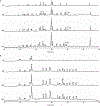Overexpression of an LaeA-like Methyltransferase Upregulates Secondary Metabolite Production in Aspergillus nidulans
- PMID: 31265232
- PMCID: PMC7310610
- DOI: 10.1021/acschembio.9b00380
Overexpression of an LaeA-like Methyltransferase Upregulates Secondary Metabolite Production in Aspergillus nidulans
Abstract
Fungal secondary metabolites (SMs) include medically valuable compounds as well as compounds that are toxic, carcinogenic, and/or contributors to fungal pathogenesis. It is consequently important to understand the regulation of fungal secondary metabolism. McrA is a recently discovered transcription factor that negatively regulates fungal secondary metabolism. Deletion of mcrA (mcrAΔ), the gene encoding McrA, results in upregulation of many SMs and alters the expression of more than 1000 genes. One gene strongly upregulated by the deletion of mcrA is llmG, a putative methyl transferase related to LaeA, a major regulator of secondary metabolism. We artificially upregulated llmG by replacing its promoter with strong constitutive promoters in strains carrying either wild-type mcrA or mcrAΔ. Upregulation of llmG on various media resulted in increased production of the important toxin sterigmatocystin and compounds from at least six major SM pathways. llmG is, thus, a master SM regulator. mcrAΔ generally resulted in greater upregulation of SMs than upregulation of llmG, indicating that the full effects of mcrA on secondary metabolism involve genes in addition to llmG. However, the combination of mcrAΔ and upregulation of llmG generally resulted in greater compound production than mcrAΔ alone (in one case more than 460 times greater than the control). This result indicates that deletion of mcrA and/or upregulation of llmG can likely be combined with other strategies for eliciting SM production to greater levels than can be obtained with any single strategy.
Conflict of interest statement
The authors declare no competing financial interest.
Figures




Similar articles
-
Discovery of McrA, a master regulator of Aspergillus secondary metabolism.Mol Microbiol. 2017 Jan;103(2):347-365. doi: 10.1111/mmi.13562. Epub 2016 Nov 14. Mol Microbiol. 2017. PMID: 27775185 Free PMC article.
-
Velvet activated McrA plays a key role in cellular and metabolic development in Aspergillus nidulans.Sci Rep. 2020 Sep 15;10(1):15075. doi: 10.1038/s41598-020-72224-y. Sci Rep. 2020. PMID: 32934285 Free PMC article.
-
Diversity of Secondary Metabolism in Aspergillus nidulans Clinical Isolates.mSphere. 2020 Apr 8;5(2):e00156-20. doi: 10.1128/mSphere.00156-20. mSphere. 2020. PMID: 32269157 Free PMC article.
-
Key role of LaeA and velvet complex proteins on expression of β-lactam and PR-toxin genes in Penicillium chrysogenum: cross-talk regulation of secondary metabolite pathways.J Ind Microbiol Biotechnol. 2017 May;44(4-5):525-535. doi: 10.1007/s10295-016-1830-y. Epub 2016 Aug 26. J Ind Microbiol Biotechnol. 2017. PMID: 27565675 Review.
-
Presence, Mode of Action, and Application of Pathway Specific Transcription Factors in Aspergillus Biosynthetic Gene Clusters.Int J Mol Sci. 2021 Aug 13;22(16):8709. doi: 10.3390/ijms22168709. Int J Mol Sci. 2021. PMID: 34445420 Free PMC article. Review.
Cited by
-
Engineering of Global Transcriptional Regulators (GTRs) in Aspergillus for Natural Product Discovery.J Fungi (Basel). 2025 Jun 12;11(6):449. doi: 10.3390/jof11060449. J Fungi (Basel). 2025. PMID: 40558961 Free PMC article. Review.
-
Involvement of LaeA and Velvet Proteins in Regulating the Production of Mycotoxins and Other Fungal Secondary Metabolites.J Fungi (Basel). 2024 Aug 8;10(8):561. doi: 10.3390/jof10080561. J Fungi (Basel). 2024. PMID: 39194887 Free PMC article. Review.
-
Deciphering chemical logic of fungal natural product biosynthesis through heterologous expression and genome mining.Nat Prod Rep. 2023 Jan 25;40(1):89-127. doi: 10.1039/d2np00050d. Nat Prod Rep. 2023. PMID: 36125308 Free PMC article. Review.
-
Impact of the White Collar Photoreceptor WcoA on the Fusarium fujikuroi Transcriptome.Front Microbiol. 2021 Jan 18;11:619474. doi: 10.3389/fmicb.2020.619474. eCollection 2020. Front Microbiol. 2021. PMID: 33574802 Free PMC article.
-
Functional Characterization of the GATA-Type Transcription Factor PaNsdD in the Filamentous Fungus Podospora anserina and Its Interplay with the Sterigmatocystin Pathway.Appl Environ Microbiol. 2022 Mar 22;88(6):e0237821. doi: 10.1128/aem.02378-21. Epub 2022 Jan 26. Appl Environ Microbiol. 2022. PMID: 35080910 Free PMC article.
References
-
- Martín JF (1998) New Aspects of genes and enzymes for β-lactam antibiotic biosynthesis. Appl. Microbiol. Biotechnol. Heidelb 50 (1), 1–15. - PubMed
-
- Keller NP, Turner G, Bennett JW (2005) Fungal secondary metabolism-from biochemistry to genomics. Nat. Rev. Microbiol 3 (12), 937–947. - PubMed
-
- Peláez F. Biological Activities of Fungal Metabolites. https://www.taylorfrancis.com/
-
- Bok JW, Hoffmeister D, Maggio-Hall LA, Murillo R, Glasner JD, Keller NP (2006) Genomic mining for Aspergillus natural products. Chem. Biol 13 (1), 31–37. - PubMed
-
- Hoffmeister D, Keller NP (2007) Natural products of filamentous fungi: enzymes, genes, and their regulation. Nat. Prod. Rep 24 (2), 393–416. - PubMed
Publication types
MeSH terms
Substances
Grants and funding
LinkOut - more resources
Full Text Sources

